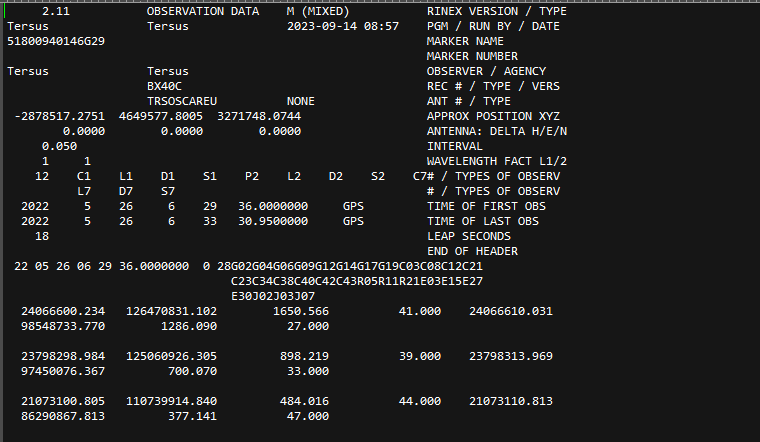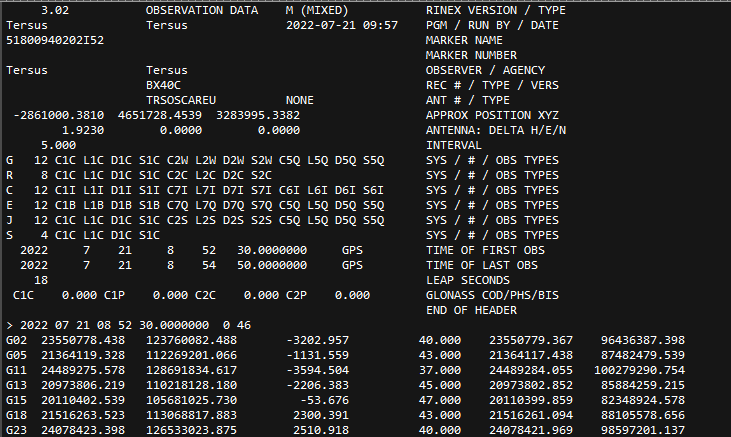What is RINEX format and its latest version?
Min Chen, Tersus GNSS 22 Sept. 2023
Receiver Independent Exchange Format (RINEX) is a standard data format widely used in GNSS survey applications.
The GNSS observations are transferred from the receiver to the computer via dedicated software and stored in binary form in a proprietary file format defined by the receiver manufacturer. Proprietary formats are defined by different GNSS receiver manufacturers and sometimes even by different product models from the same manufacturer. To solve this problem, the RINEX format was proposed in 1989 by Werner Gurtner at the Astronomical Institute, University of Berne, Switzerland. The format uses text files to store data, and the data recording format is independent of the manufacturer and the specific model of the receiver.
RINEX format has become the standard data format for GNSS survey applications. Almost all GNSS receivers provide tools to convert their format files into RINEX format files, and almost all GNSS data post-processing software can read RINEX format data directly. This means that in the actual observation operation, different manufacturers and different types of receivers can be used for mixed formation, and specific software can be used for data processing.
The most commonly used RINEX formats are version 2 and version 3. Here are the details of both versions:
RINEX 2.x
RINEX2.11, for example, defines six data types
(1) o file: GPS and GLONASS satellite observations file
(2) n file: GPS navigation message file
(3) g file: GLONASS navigation message file
(4) m file: Ground meteorological data measured at the station premises
(5) h file: GEO navigation message file
(6) c file: satellite and receiver clock file
(7) l file: Galileo navigation message file
(8) s file: the quality inspection file of TEQC
Among them, o, n, g, l files are the most common, and o, n files are necessary for GAMIT/GLOBK data processing and analysis.
Also, d files are a special compressed format that can be converted to o files using the software provided by CRX2RNX (gsi.go.jp)
File naming convention: ssssdddf.yyt
(1) ssss stands for station name
(2) ddd stands for annual product day
(3) f denotes the file sequence number (period number) of a character in a day.
f=0: The file contains all observations for the day
f=a: The file contains the files from 0 to 1 of the day, and so on to f=x for a total of 24 hours
(4) yy represents the last two digits of the year, or 22 for 2022
t denotes the data type, such as o, n, m
In addition, if it is a high-frequency receiver, it can be named as ssssdddhmm.yyo, where h is the hour of the day (a through x) and mm is the minute of the hour.
In the case of o files, each o file is divided into two parts: header file and data. From the first line to "END OF HEADER" is the header file part, and the rightmost part of each line is the header file description part, where the more important information is the receiver model, antenna type, antenna height and approximate coordinates
The header section:
Just look at the comments on the far right of each line:
(1) Receiver model: REC # / TYPE/VERS second item
(2) Antenna TYPE: ANT # / TYPE
APPROX POSITION XYZ
(4) ANTENNA height: Antenna: First term of DELTA H/E/N
Data part:
This section lists the observations of each satellite for all epochs one by one. Look for the "TYPES OF OBSERV" line in the header file, where the first number (12 in this case) represents a total of 12 observations. Then find the data section, you will find that this is a group of 12 numbers, corresponding to the 12 types of data in the above figure C1 to S7.

RINEX version 3.x
The file format is reduced to three types: observation file, navigation file and meteorological file
There are only two file extensions:
1..rnx: This represents an RINEX file in a standard format
2.crx: Represents Compact RINEX compressed format
Used on naming < SSSS > < MR > < CCC > _ < S > _ < YYYYDDDHHMM > _ < NNN > _ < FRQ > _ < TT >, < FMT >. Gz
Among them:
(1) SSSS: station name
(2) MR: The receiver number
CCC: three-digit ISO country code
(4) S: The data source, which is R when the data comes from the receiver and S when it comes from the data stream
(5) YYYYDDDHHMM: year, year product day, hour, minute
6.nnn: Length of observation period; for example, 01D is one day
(7) FRQ: The sampling interval or sampling frequency during observation, 01S is 1 second, 05Z is 5Hz
(8) TT: satellite system and data type included,
First: M (hybrid constellation), G (GPS), R (GLONASS), C (BD), E (Galileo), J (QZSS), I (IRNSS), one of
Second place: Data types O, N, M
(9) FMT: Extension, .rnx and.crx
Apart from these obvious changes, most of them are details/format changes. For most of the rest you can refer to RINEX 2.x.

RINEX has been updated by the International GNSS Service (IGS) to version 4.01 in July 2023, The main changes with respect to the previous version (4.00) are:
1) Addition of New GPS L1 & L2 Observation Code for RMP antenna (code names are now reserved)
2) New NavIC L1 Observation Code (signal already transmitted by the ISRO NVS-01 satellite launched at the end of May this year)
About Tersus GNSS Inc.
Tersus GNSS is a leading Global Navigation Satellite System (GNSS) solution provider. Our offerings and services aim to make centimeter-precision positioning affordable for large-scale deployment.
Founded in 2014, we have been pioneers in design and development GNSS RTK products to better cater to the industry’s needs. Our portfolios cover GNSS RTK & PPK OEM boards, David GNSS Receiver, Oscar GNSS Receiver, MatrixRTK [GNSS CORS Systems] and inertial navigation systems.
Designed for ease of use, our solutions support multi-GNSS and provide flexible interfaces for a variety of applications, such as UAVs, surveying, mapping, precision agriculture, lane-level navigation, construction engineering, and deformation monitoring.
Sales inquiry: sales@tersus-gnss.com
Technical support: support@tersus-gnss.com
